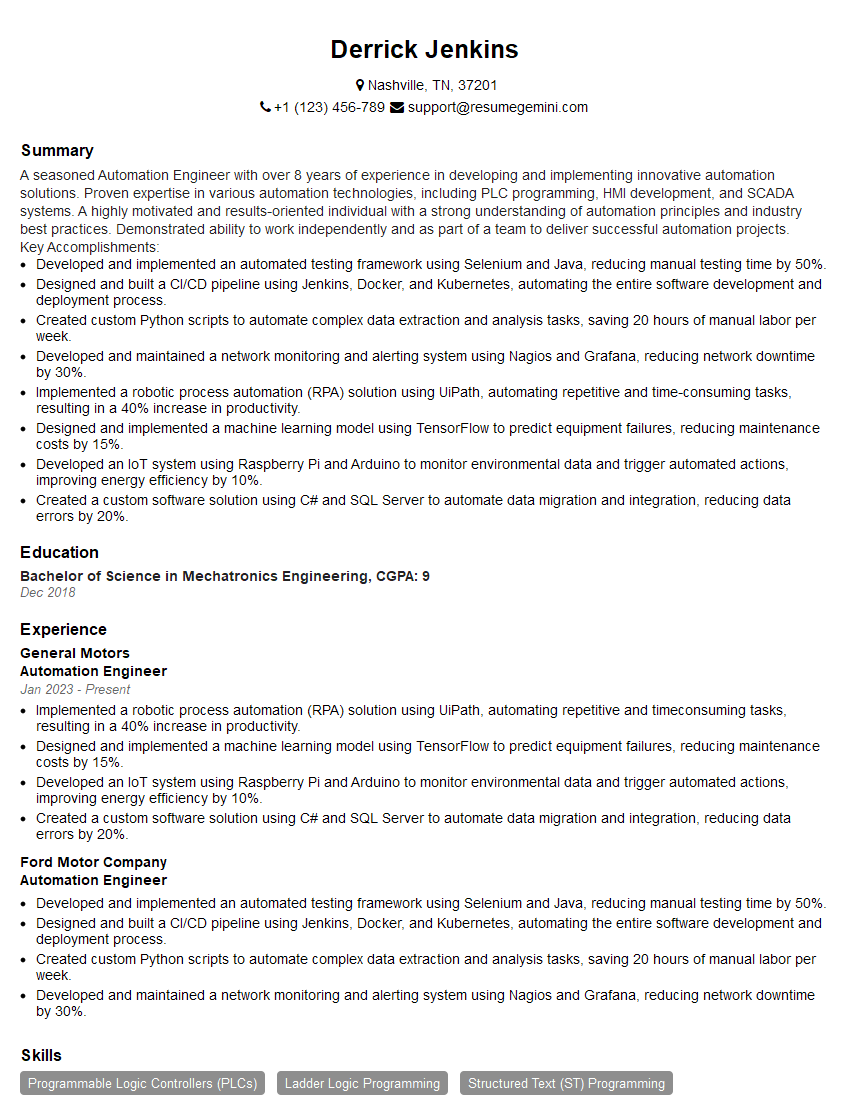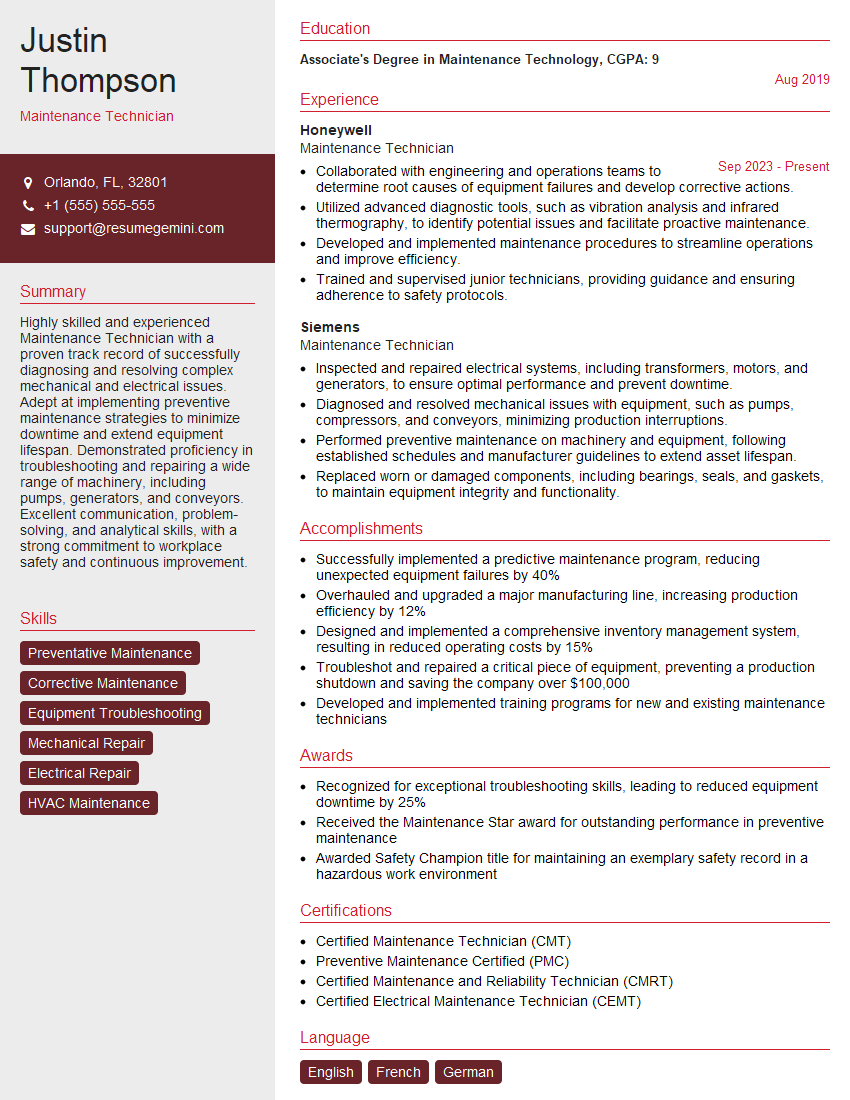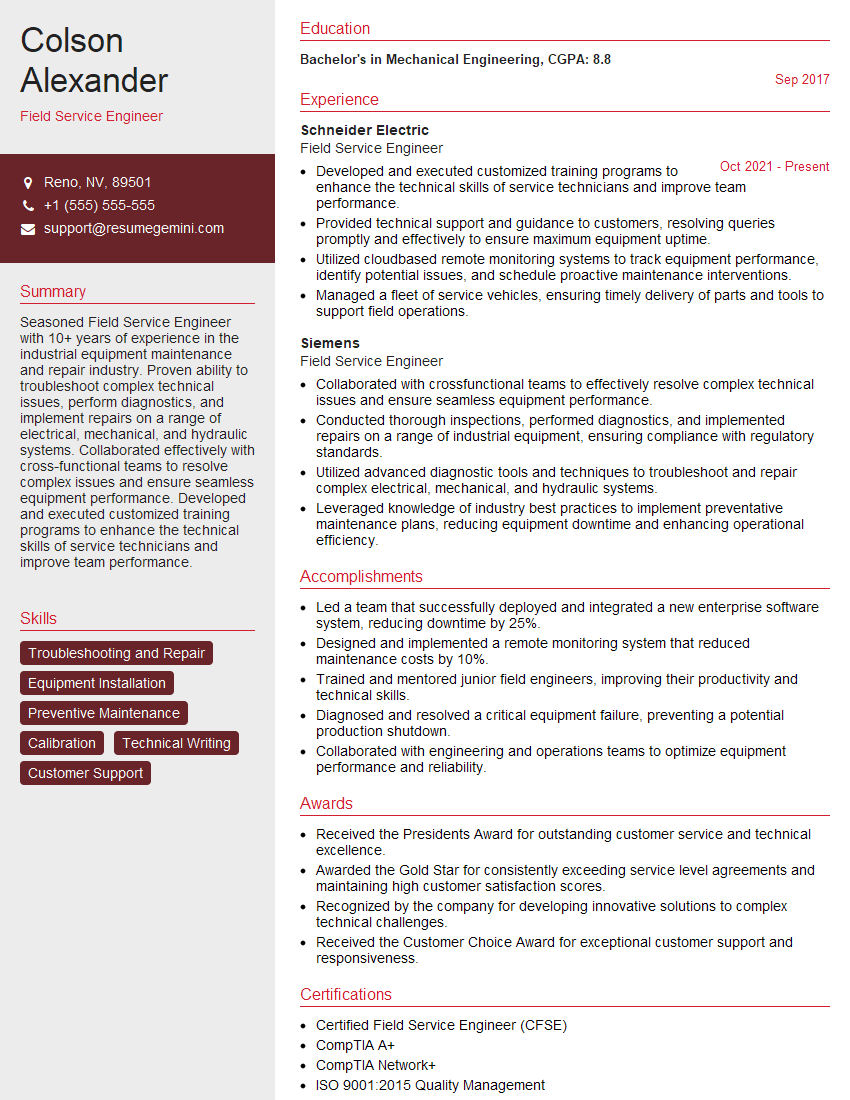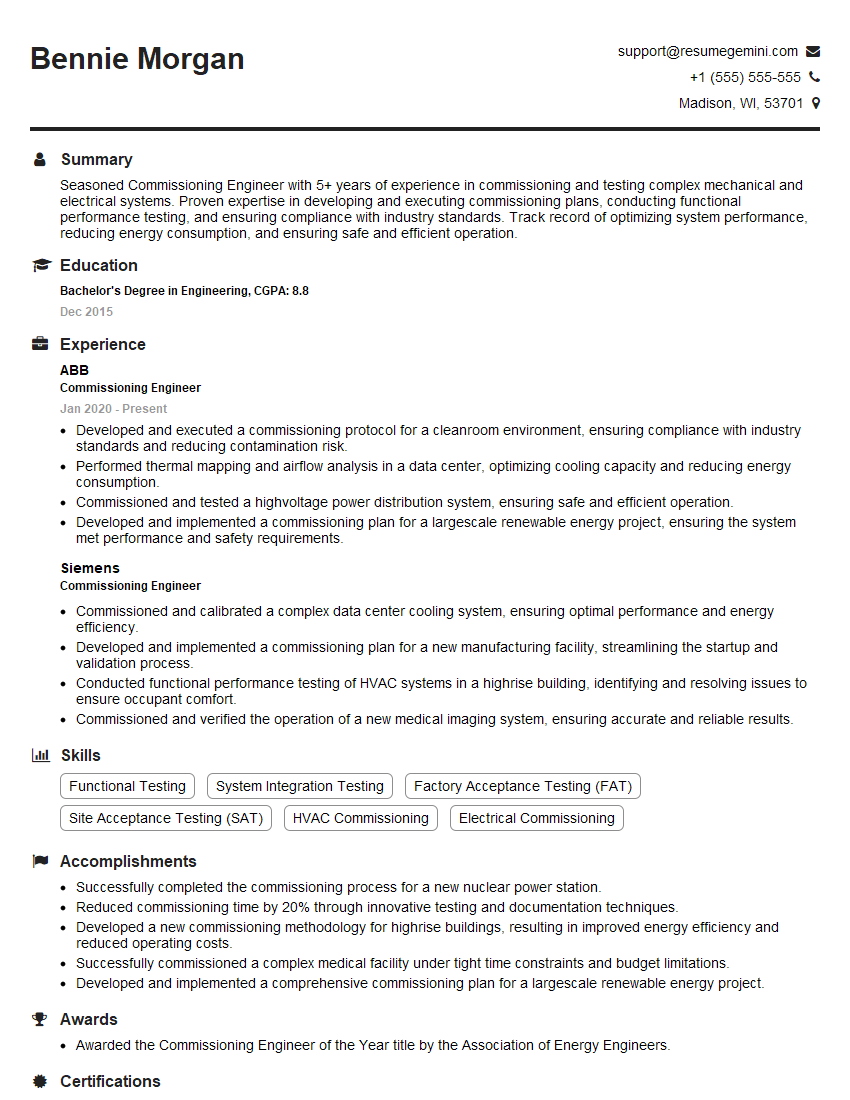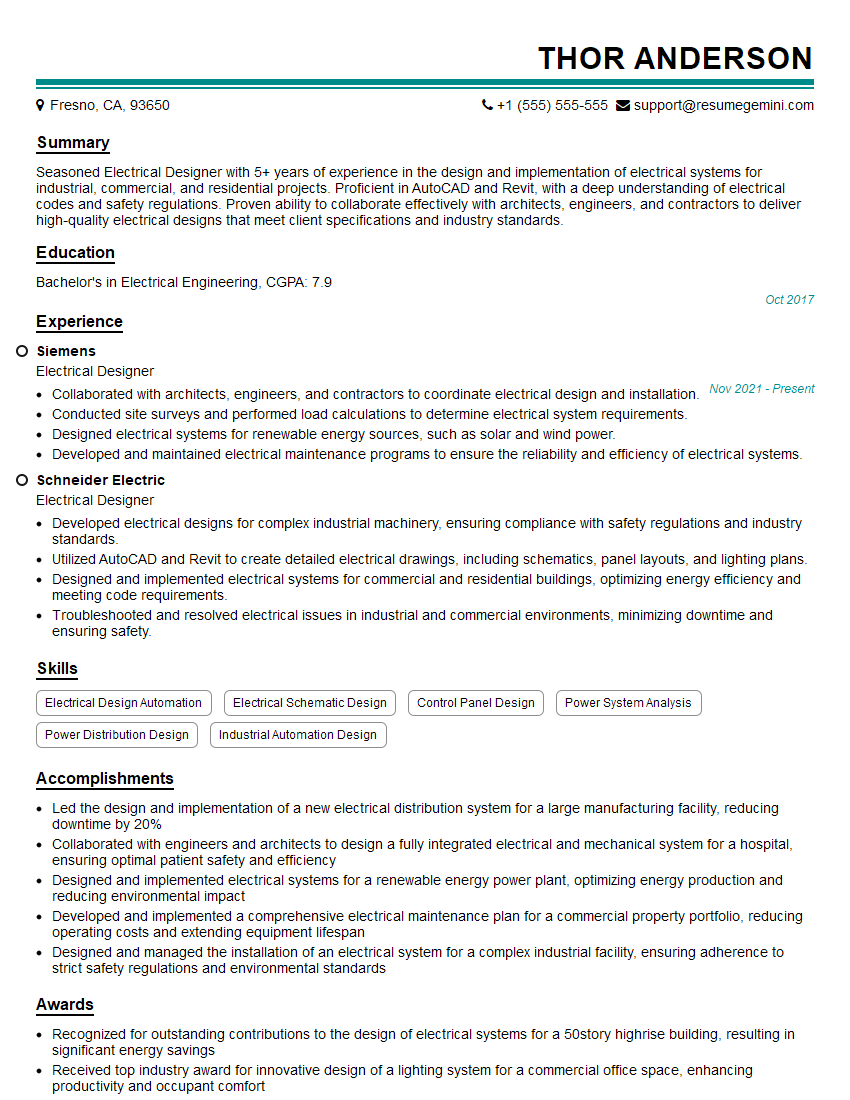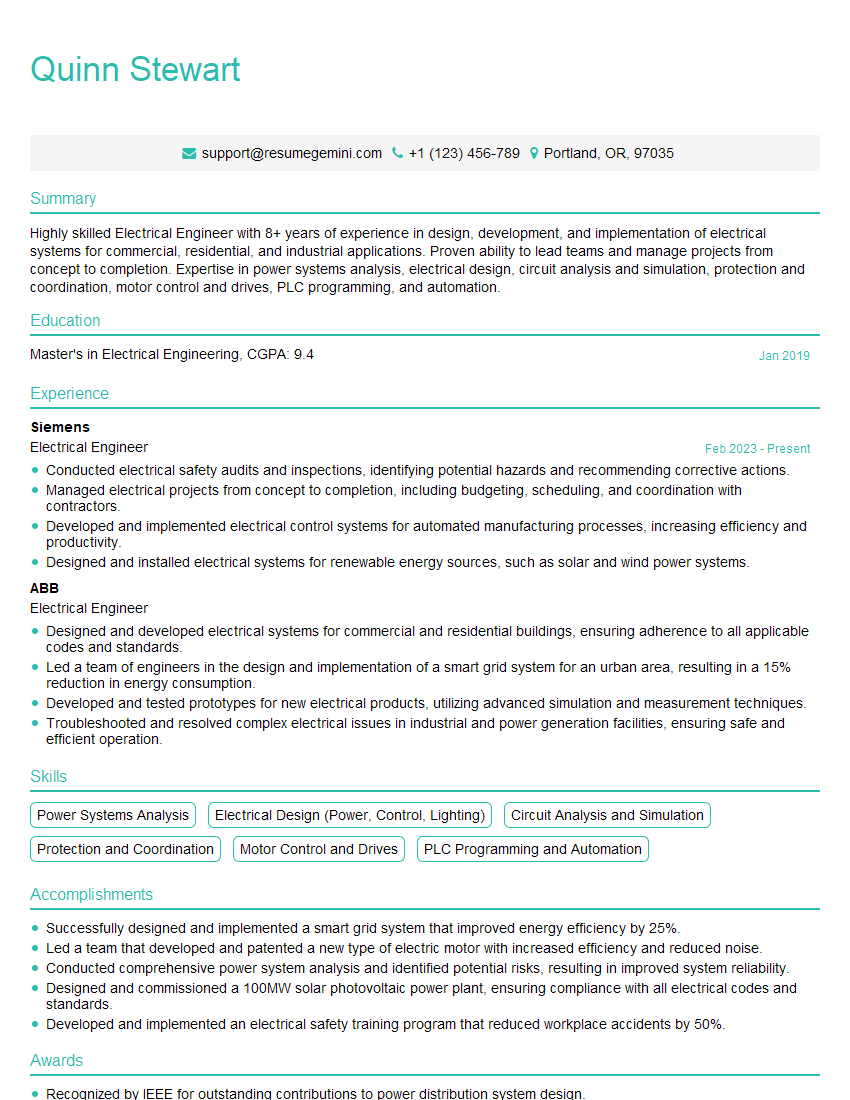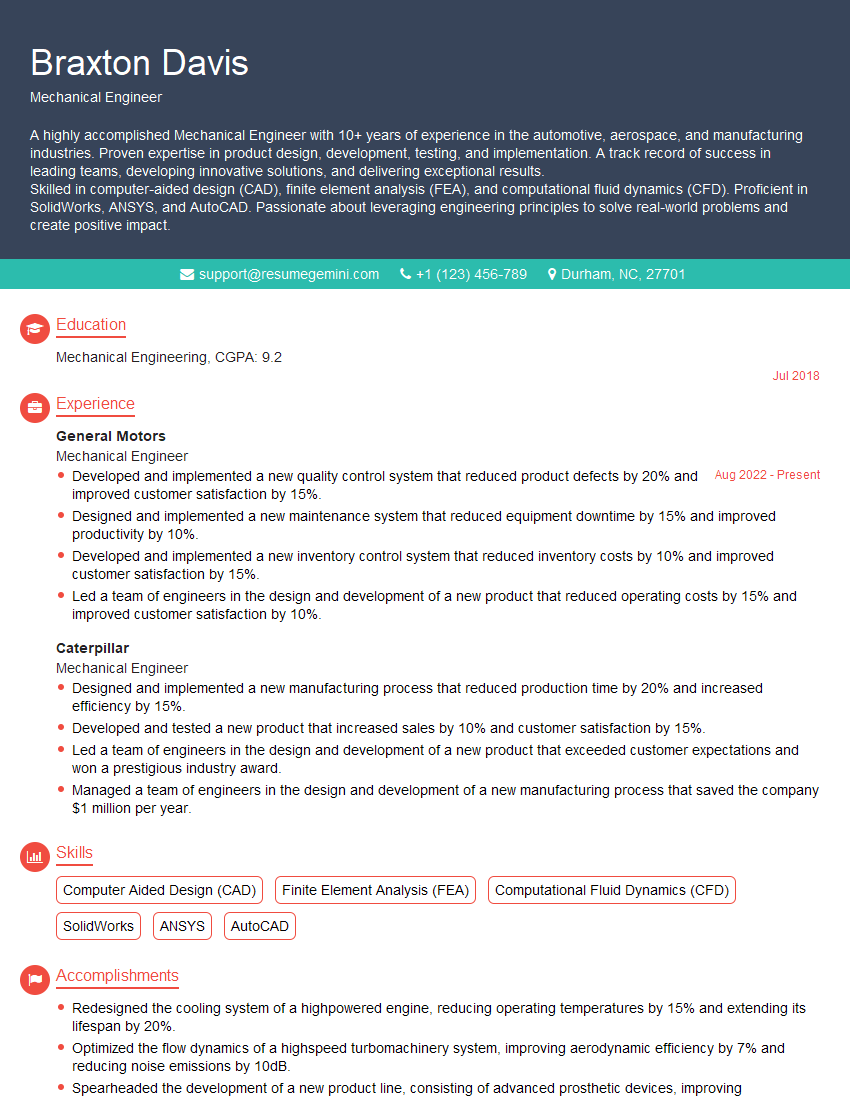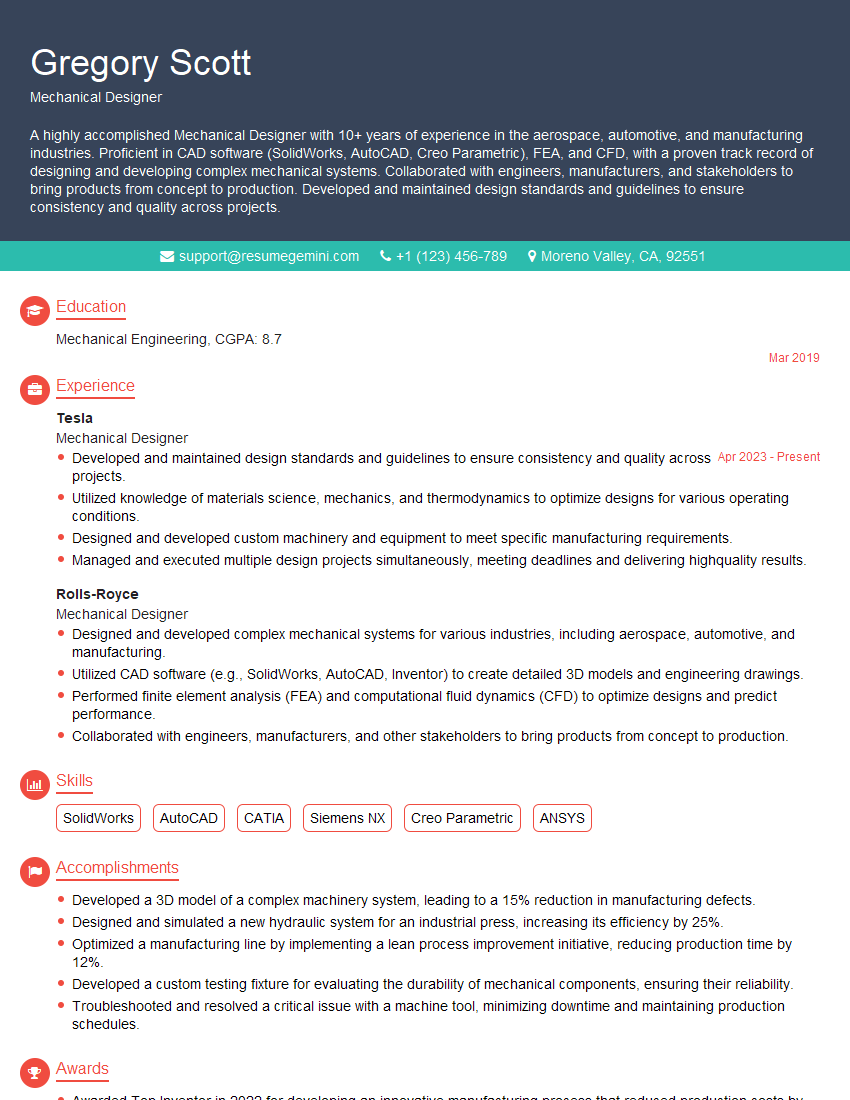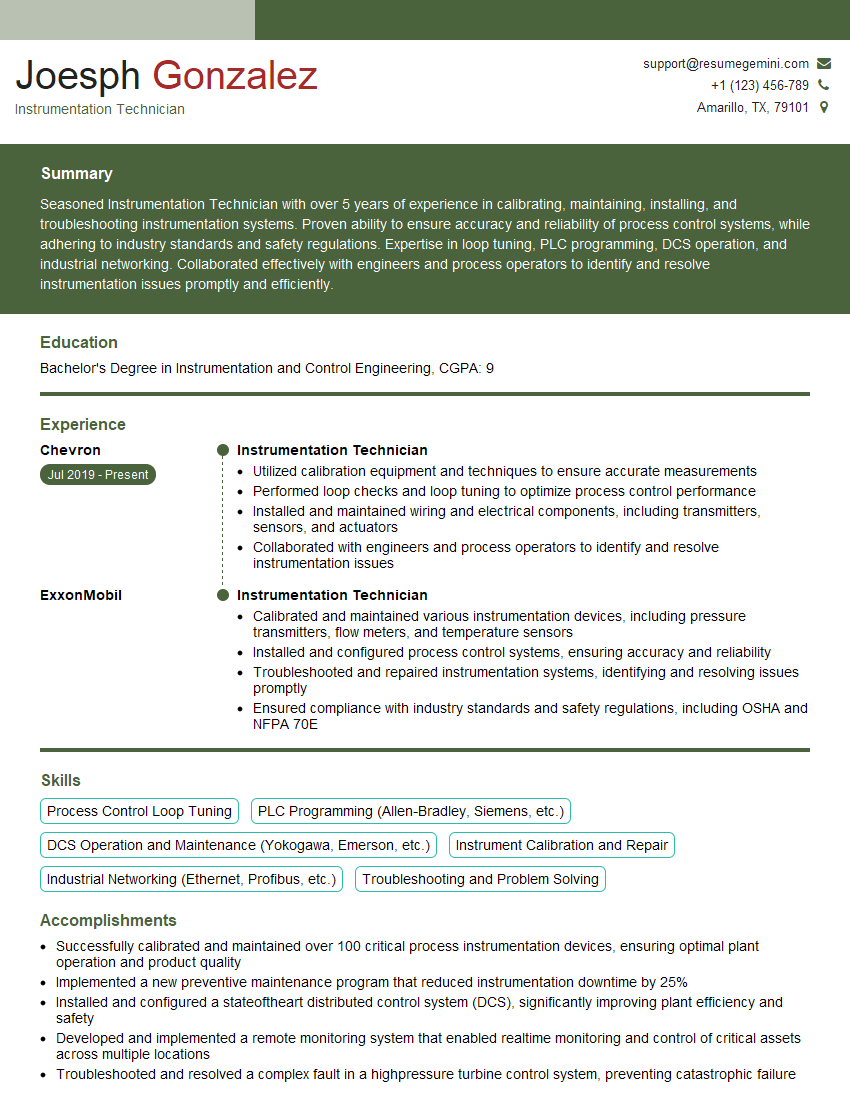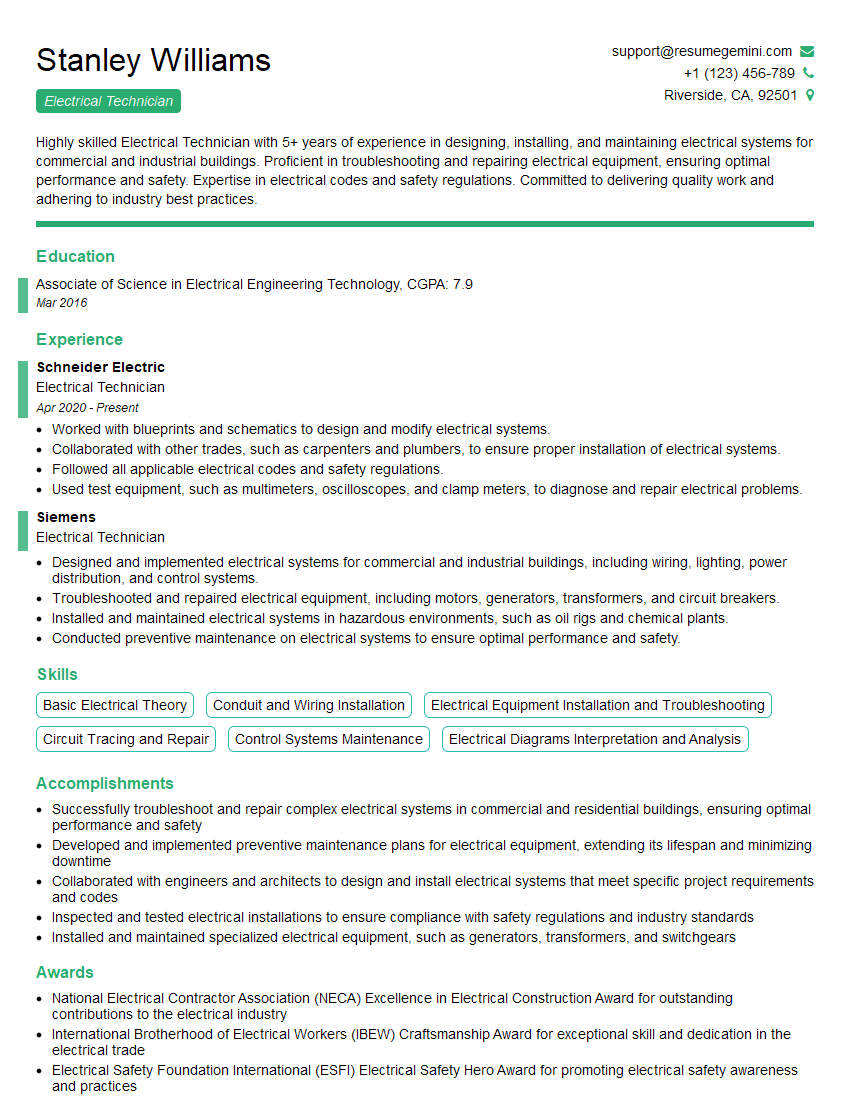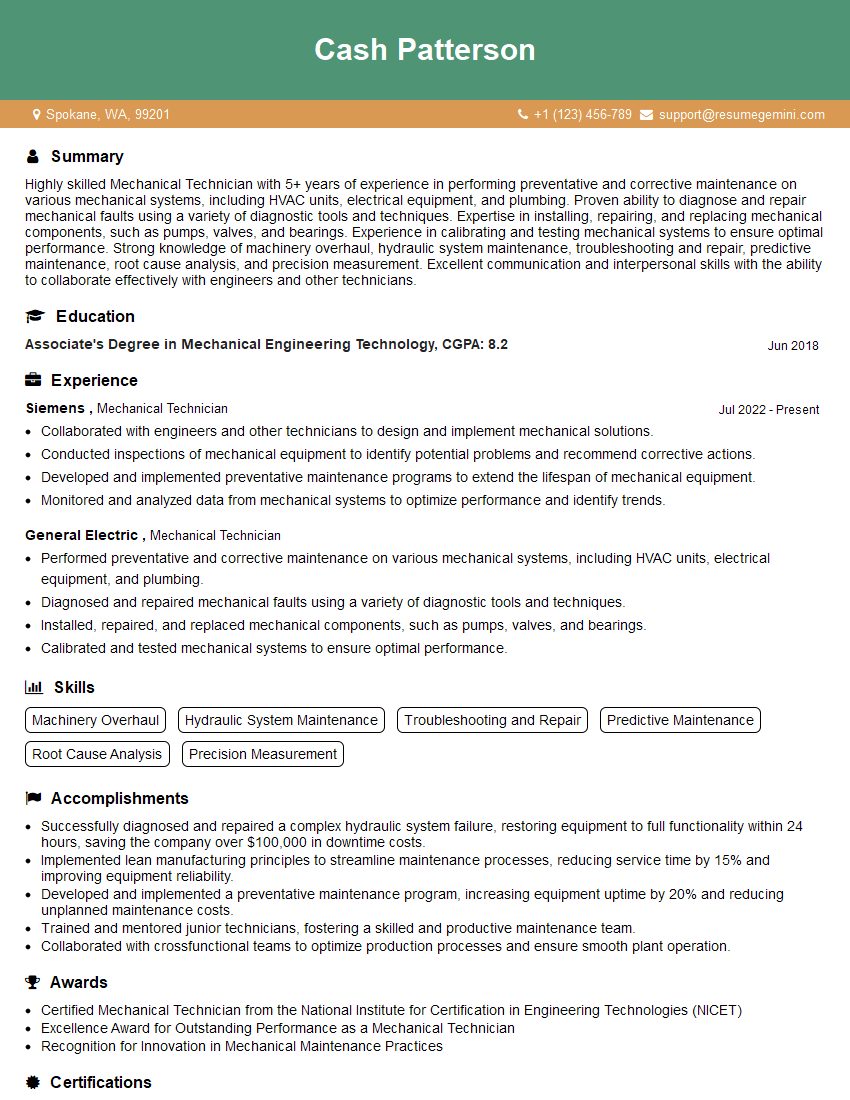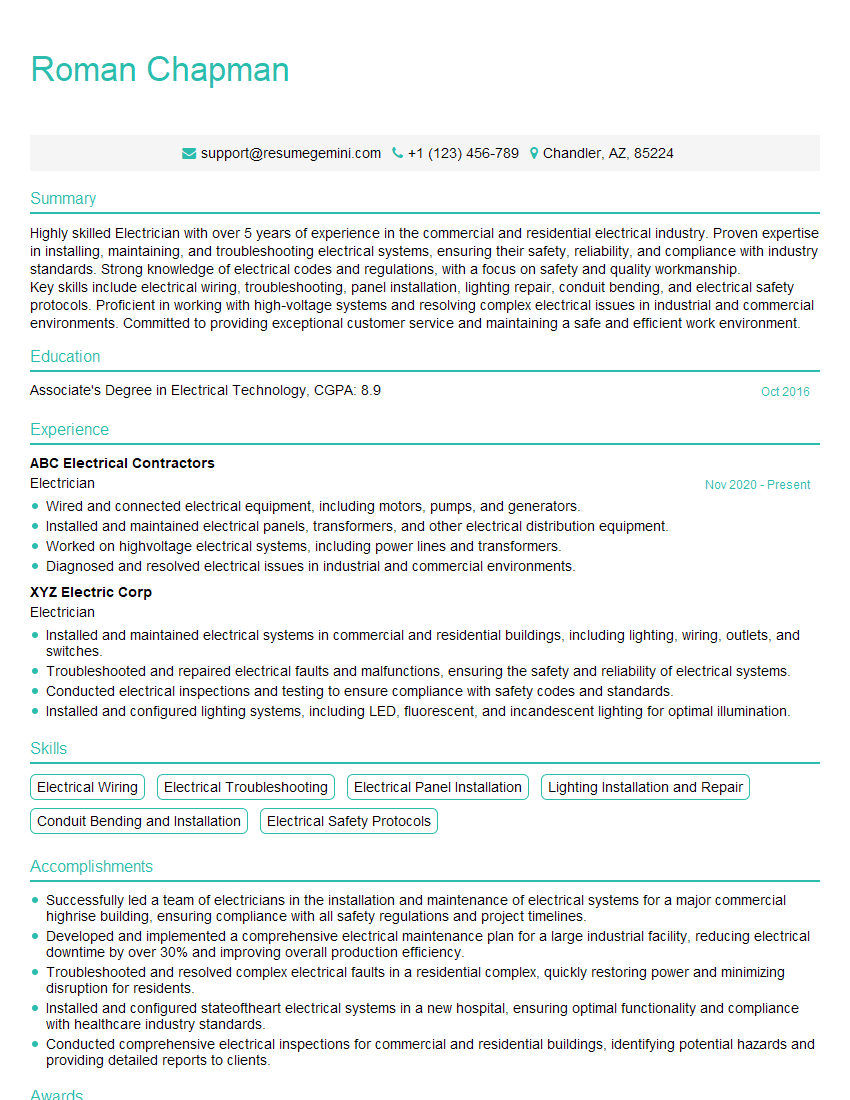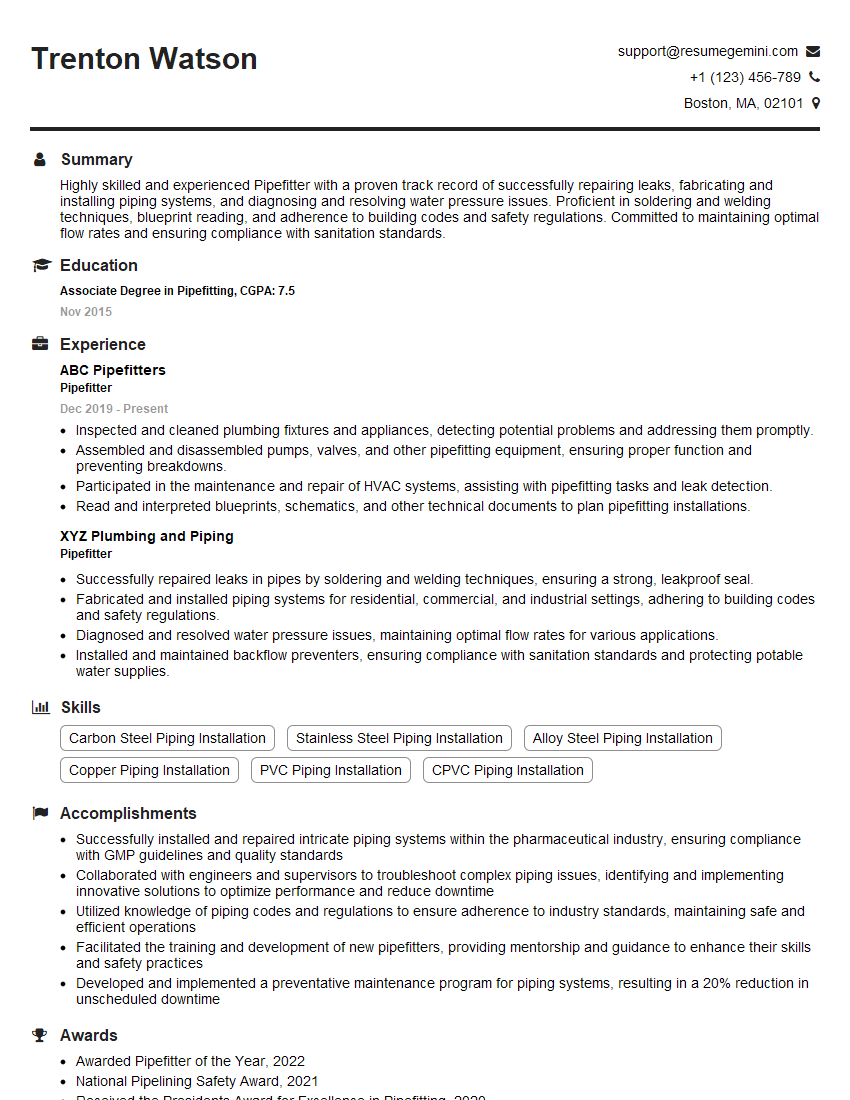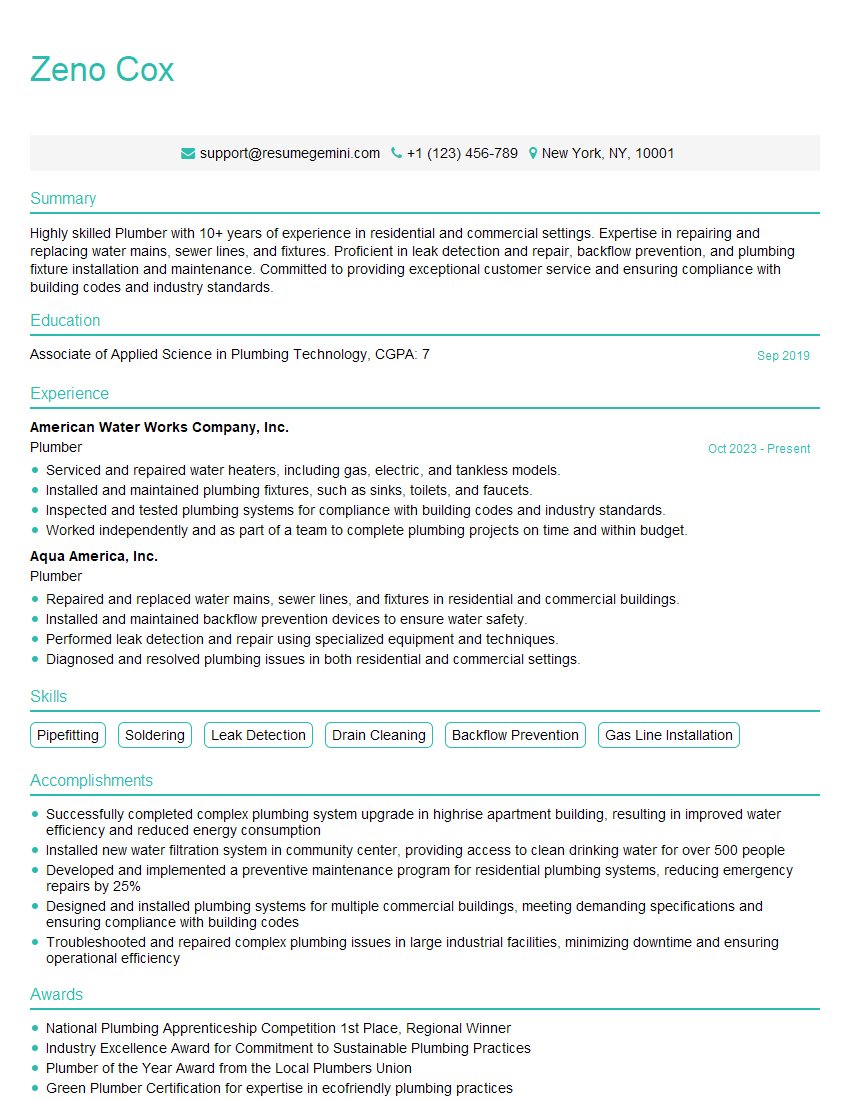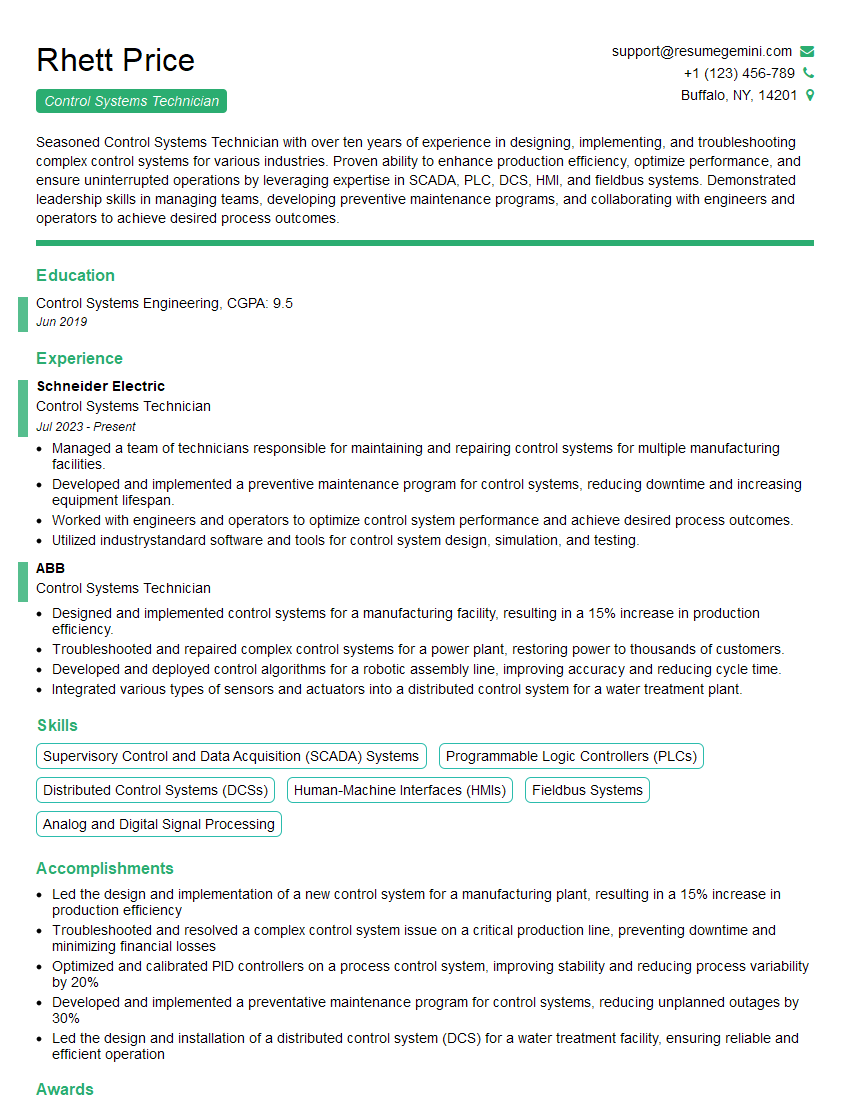The thought of an interview can be nerve-wracking, but the right preparation can make all the difference. Explore this comprehensive guide to Electrical and Mechanical Installations interview questions and gain the confidence you need to showcase your abilities and secure the role.
Questions Asked in Electrical and Mechanical Installations Interview
Q 1. Explain the difference between AC and DC electricity.
The fundamental difference between AC (Alternating Current) and DC (Direct Current) electricity lies in the direction of electron flow. In DC, electrons flow consistently in one direction, like a river flowing downstream. This is the type of electricity produced by batteries. AC, on the other hand, involves electrons that periodically change direction, oscillating back and forth like a pendulum. This is the type of electricity that powers our homes and industries.
Think of it like this: DC is like a steady stream of water, while AC is like a wave that moves back and forth. DC is simpler to understand in terms of direction, but AC offers advantages in terms of efficient long-distance transmission and ease of transformation between voltages.
- DC: Used in batteries, electronic devices, and some industrial applications.
- AC: Used in power grids, household appliances, and most industrial machinery.
Q 2. Describe the various types of electrical wiring systems.
Electrical wiring systems are categorized based on several factors, including voltage levels, wiring materials, and installation methods. Some common types include:
- Conduit Wiring: Wires are run inside protective metal or plastic pipes (conduits), providing excellent protection against physical damage and environmental factors. This is common in commercial and industrial settings.
- Cable Wiring: Wires are pre-assembled within an outer sheath, simplifying installation. This is often seen in residential wiring and less demanding applications.
- Surface Mount Wiring: Wires are attached to the surface of walls or ceilings using clips or other fastening systems. This method is quicker but less aesthetically pleasing than concealed wiring.
- Underground Wiring: Wires are buried beneath the ground, often using specialized cables designed to withstand moisture and soil conditions. This ensures safety and a clean appearance but requires careful planning and excavation.
The choice of wiring system depends heavily on the specific application, considering factors such as cost, safety regulations, aesthetics, and environmental conditions. For example, in a hazardous location like a chemical plant, conduit wiring offers superior protection from potential explosions compared to surface mount wiring.
Q 3. How do you troubleshoot a faulty electrical circuit?
Troubleshooting a faulty electrical circuit is a systematic process requiring careful attention to safety. Here’s a step-by-step approach:
- Safety First: Always de-energize the circuit before starting any troubleshooting. This involves switching off the relevant circuit breaker or disconnecting the power source.
- Visual Inspection: Carefully examine all wiring, connections, and components for any obvious signs of damage such as loose wires, burnt insulation, or broken components.
- Voltage Testing: Use a multimeter to check voltage levels at various points in the circuit. This helps identify where the voltage is dropping or absent, indicating the location of the fault.
- Continuity Testing: Use a multimeter to check the continuity of wires and components. This ensures that there are no breaks or open circuits.
- Component Testing: Individually test components like switches, outlets, and circuit breakers to identify faulty parts. Replace any malfunctioning components.
- Load Testing: After repairs, carefully test the circuit under load (i.e., with the connected appliances operating) to confirm the problem is resolved.
Remember to always consult relevant electrical codes and standards throughout the troubleshooting process. A clear understanding of circuit diagrams is essential for effective troubleshooting.
Q 4. What safety precautions do you take when working with high-voltage equipment?
Working with high-voltage equipment is inherently dangerous. Safety must be the paramount concern. Here are crucial safety precautions:
- Lockout/Tagout Procedures: Always follow strict lockout/tagout procedures to prevent accidental energization of the equipment. This involves physically locking out the power source to prevent unintended activation.
- Personal Protective Equipment (PPE): Wear appropriate PPE, including insulated gloves, safety glasses, and arc-flash protective clothing, rated for the voltage level. This protection is vital in case of accidental contact.
- Proper Training: Only trained and authorized personnel should work with high-voltage equipment. Thorough knowledge of safety procedures and equipment operation is crucial.
- Grounding: Properly ground all equipment and tools to prevent the buildup of static electricity or stray voltages.
- Work Permits: Obtain necessary work permits before commencing work on high-voltage systems.
- Emergency Procedures: Ensure that emergency procedures, including first aid and emergency contact information, are readily available and understood by all personnel.
Never compromise on safety. If in doubt, consult a qualified electrician.
Q 5. Explain the principles of hydraulic and pneumatic systems.
Hydraulic and pneumatic systems both utilize fluids to transmit power, but they differ in the type of fluid used. Hydraulic systems use incompressible liquids, typically oil, while pneumatic systems use compressible gases, typically air.
- Hydraulic Systems: Rely on the pressure of a liquid to generate force and movement. They provide high power density, precise control, and the ability to handle heavy loads. Examples include hydraulic presses, excavators, and braking systems.
- Pneumatic Systems: Use compressed air to power mechanisms. They offer advantages in terms of safety (air is less hazardous than oil), ease of maintenance, and lower cost. Examples include pneumatic tools, automated assembly lines, and air brakes.
Both systems employ similar principles: a pump generates pressure, the pressurized fluid is transmitted through pipes and valves, and actuators (like cylinders) convert the fluid pressure into mechanical motion. However, the compressibility of air in pneumatic systems requires consideration for factors like response time and pressure fluctuations that don’t significantly impact hydraulic systems.
Q 6. Describe different types of pumps and their applications.
Various types of pumps are used in both hydraulic and pneumatic systems, each tailored for specific applications:
- Centrifugal Pumps: These use rotating impellers to accelerate fluid outwards, increasing its velocity and pressure. They are commonly used in water supply systems and industrial processes.
- Positive Displacement Pumps: These displace a fixed volume of fluid with each stroke, generating high pressure. Subtypes include gear pumps, vane pumps, and piston pumps. These are prevalent in hydraulic systems requiring precise control and high pressure.
- Diaphragm Pumps: These use a flexible diaphragm to pump fluid, suitable for handling viscous fluids and slurries. They are useful in various industrial and chemical applications.
- Air Compressors: These are essential components of pneumatic systems, compressing air to the required pressure. Types include reciprocating compressors, rotary screw compressors, and centrifugal compressors, each with its own pressure and flow rate capabilities.
The selection of a pump depends critically on factors like the fluid being pumped, required flow rate, pressure, viscosity, and cost considerations.
Q 7. How do you troubleshoot a malfunctioning pneumatic system?
Troubleshooting a malfunctioning pneumatic system involves a systematic approach similar to electrical troubleshooting, emphasizing safety.
- Safety First: De-energize the system by turning off the air compressor and releasing system pressure.
- Visual Inspection: Check for leaks, loose connections, damaged hoses or tubing, and any signs of physical damage.
- Pressure Testing: Use a pressure gauge to check pressure levels at various points in the system. A significant pressure drop suggests a leak or blockage.
- Leak Detection: Use soapy water to locate air leaks in hoses and fittings. Leaks will appear as bubbles.
- Component Testing: Check individual components like valves, cylinders, and filters for proper operation. Replace or repair faulty parts.
- Air Filter Inspection: A clogged air filter can restrict airflow and affect system performance.
- Lubrication: Check and lubricate moving parts as needed.
Troubleshooting pneumatic systems often involves listening for unusual sounds like hissing or unusual noises from components. A systematic approach, combined with careful observation and testing, will typically pinpoint the source of the malfunction.
Q 8. What are the different types of bearings and their applications?
Bearings are essential mechanical components that reduce friction and support load between moving parts. Different bearing types are chosen based on the specific application’s requirements for load capacity, speed, and operating environment.
- Ball Bearings: These consist of steel balls rolling between an inner and outer race. They excel in high-speed applications and handle radial loads effectively. Think of the bearings in a bicycle wheel.
- Roller Bearings: Utilize cylindrical or tapered rollers instead of balls, providing higher load capacity than ball bearings, particularly for heavier radial and thrust loads. These are common in heavy machinery like conveyor systems.
- Plain Bearings (Sleeve Bearings): Simpler in design, these use a sleeve of a softer material (e.g., bronze or babbitt) that surrounds a shaft. They are suitable for low-speed, moderate-load applications and are often self-lubricating.
- Thrust Bearings: Designed to handle axial loads (forces pushing or pulling along the shaft’s axis). They are crucial in applications like propellers or vertical shafts.
- Tapered Roller Bearings: These combine the benefits of both radial and thrust load capacity, making them ideal for applications experiencing both types of force simultaneously, like car wheel hubs.
Choosing the right bearing is critical. A poorly chosen bearing can lead to premature failure, increased friction, and system downtime. For example, using a ball bearing in a heavy-duty application would likely result in premature failure, whereas a plain bearing in a high-speed application would experience excessive wear and heat generation.
Q 9. Explain the concept of thermal expansion and its implications in mechanical systems.
Thermal expansion refers to the tendency of materials to change in size (length, area, or volume) in response to temperature changes. Most materials expand when heated and contract when cooled. This is a crucial factor to consider in mechanical systems because uncontrolled expansion can lead to significant problems.
Implications in Mechanical Systems:
- Stress and Strain: Uneven expansion can induce stress within components, potentially leading to cracking, warping, or failure. Imagine a long metal bridge – differential expansion between different parts of the bridge due to sun exposure on one side can generate substantial stress.
- Misalignment: Expansion can cause misalignment of shafts, gears, and other moving parts, affecting performance and potentially causing damage. A classic example is a tightly fitted shaft expanding more than its housing, leading to binding.
- Clearances and Gaps: Designing adequate clearances between components is critical to accommodate thermal expansion. Insufficient clearance can lead to binding, while excessive clearance can affect precision and stability.
Mitigation Strategies:
- Material Selection: Choose materials with low coefficients of thermal expansion where applicable.
- Expansion Joints: Incorporate expansion joints (like bellows or loops) in piping systems or structures to accommodate changes in length.
- Pre-stressing: Pre-stress components to compensate for anticipated expansion.
Understanding and managing thermal expansion is vital for ensuring the longevity and reliability of mechanical systems.
Q 10. How do you interpret mechanical drawings and schematics?
Interpreting mechanical drawings and schematics requires a systematic approach and understanding of engineering symbols and conventions. It’s like reading a map for a mechanical system.
Steps to Interpretation:
- Title Block: Begin by examining the title block for essential information: drawing number, revision, scale, date, and designer.
- Views and Projections: Understand different views (front, top, side) and projections (orthographic, isometric) to visualize the 3D geometry.
- Dimensions and Tolerances: Accurately measure components using the provided dimensions and consider tolerances (acceptable variations in size).
- Material Specifications: Identify materials used for each component. This is usually denoted by a specific symbol or a reference to a material specification.
- Bill of Materials (BOM): Review the BOM for a list of components, quantities, and part numbers.
- Assembly Drawings: If applicable, understand the assembly sequence from exploded views or assembly instructions.
- Symbols and Conventions: Familiarize yourself with standard engineering symbols representing various components (e.g., screws, welds, surface finishes).
Practice is key. Start with simpler drawings and gradually progress to more complex ones. Online resources and textbooks offer extensive information on drafting standards and symbol interpretation.
Q 11. Describe your experience with different types of welding techniques.
My experience encompasses a range of welding techniques, each suited to different materials and applications.
- Shielded Metal Arc Welding (SMAW): A versatile and widely used process employing a consumable electrode coated with flux to protect the weld pool from atmospheric contamination. Ideal for field applications, even in remote areas, because it requires minimal specialized equipment.
- Gas Metal Arc Welding (GMAW) or MIG Welding: Uses a continuous wire electrode fed into the weld pool, with a shielding gas to protect the weld. Higher deposition rates and excellent penetration make it efficient for thicker materials.
- Gas Tungsten Arc Welding (GTAW) or TIG Welding: A precise process using a non-consumable tungsten electrode, requiring a separate filler metal. Produces high-quality welds with excellent appearance and is ideal for thin materials and critical applications.
- Resistance Welding: This process utilizes electric current to heat and fuse metal parts, primarily used for joining sheet metal. Spot welding and seam welding are common types.
In each process, the selection of appropriate parameters (such as amperage, voltage, travel speed, and shielding gas type) is crucial for producing a strong, sound weld. I am proficient in the inspection and quality control aspects, understanding the importance of testing welds for defects.
Q 12. What are the common causes of motor overheating?
Motor overheating is a common problem with several potential causes, often leading to decreased efficiency, damage, and even failure.
- Overloading: Exceeding the motor’s rated power capacity is a primary cause. Trying to drive a heavier load than designed will generate excessive heat.
- Insufficient Ventilation: Inadequate airflow around the motor prevents effective heat dissipation. Dust buildup or blockage of ventilation openings can severely restrict cooling.
- Bearing Failure: Worn or damaged bearings increase friction, generating significant heat. The characteristic squealing sound is a tell-tale sign.
- Winding Faults: Internal shorts or open circuits within the motor windings create excessive heat.
- Electrical Problems: Incorrect voltage supply, high inrush current, or unbalanced power phases can result in overheating.
- Ambient Temperature: High operating temperatures around the motor can reduce its ability to dissipate heat.
Diagnosing the cause requires systematic inspection, including checking for signs of overloading, examining bearings, and potentially performing electrical tests on windings. Regular preventative maintenance, including cleaning and lubrication, significantly reduces the risk of overheating.
Q 13. How do you perform preventative maintenance on electrical equipment?
Preventative maintenance on electrical equipment is crucial for safety, reliability, and longevity. A proactive approach prevents costly repairs and downtime.
Key Aspects of Preventative Maintenance:
- Visual Inspection: Regularly check for loose connections, damaged insulation, corrosion, and signs of overheating. Look for burn marks, discoloration, and loose wires.
- Cleaning: Remove dust, debris, and contaminants from equipment surfaces and internal components. Compressed air is often useful, but be mindful of potential damage to sensitive components.
- Tightening Connections: Periodically check and tighten terminal connections to ensure good electrical contact. Loose connections are a major source of failures.
- Lubrication: For equipment with moving parts, apply appropriate lubricants to reduce friction and wear.
- Testing: Employ insulation resistance testing, continuity checks, and other relevant tests to ensure the equipment’s electrical integrity.
- Documentation: Maintain detailed records of inspections, maintenance tasks, and any findings. This is crucial for tracking trends and making informed decisions.
The frequency of preventative maintenance depends on the equipment type and operating conditions. High-usage equipment requires more frequent checks.
Q 14. How do you perform preventative maintenance on mechanical equipment?
Preventative maintenance on mechanical equipment focuses on minimizing wear and tear, detecting potential problems early, and maximizing the lifespan of the equipment.
Common Preventative Maintenance Tasks:
- Lubrication: Regular lubrication of bearings, gears, and other moving parts reduces friction, prevents wear, and extends service life. The type and frequency of lubrication depend on the application and lubricant specification.
- Inspection of Moving Parts: Regularly check for wear, damage, and misalignment in gears, belts, chains, and other moving components. Look for unusual noises, vibrations, or signs of excessive wear.
- Cleaning: Remove dirt, debris, and contaminants that can accumulate on equipment surfaces and affect performance. Compressed air can be used for external cleaning; internal cleaning may require disassembly.
- Tightening Bolts and Fasteners: Periodically check and tighten bolts and fasteners to prevent loosening and potential damage.
- Vibration Analysis: In some cases, vibration analysis can help detect early signs of bearing wear, imbalance, or other mechanical problems.
- Fluid Level Checks: Monitor the fluid levels in hydraulic and lubrication systems. Low levels can indicate leaks or other issues.
A well-defined preventative maintenance schedule tailored to the specific equipment significantly reduces downtime and extends its operational life.
Q 15. Explain the process of installing conduit and wiring.
Installing conduit and wiring is a crucial aspect of any electrical installation, ensuring safe and efficient power distribution. The process begins with careful planning, referencing blueprints and electrical schematics to determine the optimal conduit routing and wire sizing.
1. Planning and Preparation: This involves identifying the locations of electrical outlets, switches, lighting fixtures, and other electrical components. We then determine the best route for the conduit, considering factors like accessibility, structural integrity, and safety regulations. Proper wire sizing is calculated based on the anticipated load and the length of the run to ensure sufficient current carrying capacity and voltage drop compliance.
2. Conduit Installation: We use various conduit materials such as PVC, EMT (electrical metallic tubing), or rigid conduit, depending on the application and environmental conditions. The conduit is carefully installed, using appropriate bending techniques to avoid kinks and sharp bends that could damage the wires. Secure mounting using straps and clamps is vital for structural integrity. We also ensure that conduit runs are properly grounded.
3. Wire Pulling: After installing the conduit, we pull the appropriate gauge and type of wiring through the conduit. We always employ wire pulling lubricants to minimize friction and damage to the wires. Proper wire labeling and color-coding ensures easy identification and future maintenance.
4. Termination and Connections: Once the wires are pulled, we carefully terminate them at the junction boxes, electrical panels, and other devices, ensuring all connections are secure and conform to electrical codes. We typically use wire nuts for joining wires within junction boxes, and terminal blocks for more robust and organized connections.
5. Testing and Inspection: Finally, we conduct thorough testing to ensure continuity, proper grounding, and the absence of short circuits. This involves using specialized testing equipment such as multimeters and insulation resistance testers. All work must meet local and national electrical codes (like NEC in the US).
Example: In a recent commercial project, we installed EMT conduit for the main power supply to a server room. We used larger diameter conduit to accommodate multiple power cables, ensuring future expansion capabilities. We also implemented a grounding system with appropriate grounding rods for the entire run.
Career Expert Tips:
- Ace those interviews! Prepare effectively by reviewing the Top 50 Most Common Interview Questions on ResumeGemini.
- Navigate your job search with confidence! Explore a wide range of Career Tips on ResumeGemini. Learn about common challenges and recommendations to overcome them.
- Craft the perfect resume! Master the Art of Resume Writing with ResumeGemini’s guide. Showcase your unique qualifications and achievements effectively.
- Don’t miss out on holiday savings! Build your dream resume with ResumeGemini’s ATS optimized templates.
Q 16. Describe your experience with different types of piping systems.
My experience encompasses a wide range of piping systems, including:
- Steel Piping: Frequently used for high-pressure applications, requiring specialized welding and fitting techniques for durability and leak prevention. I’ve worked with both black iron pipe and galvanized steel pipe, understanding their respective applications and limitations. Proper sizing and support structures are essential.
- Copper Piping: Commonly used for plumbing and HVAC systems, offering corrosion resistance and ease of installation. I’m proficient in different joining methods, including soldering, brazing, and compression fittings. Proper purging and pressure testing are critical for leak prevention.
- PVC Piping: A cost-effective and lightweight option suitable for various applications, including drainage and chemical handling. I have experience with solvent welding and threaded fittings. Careful handling is necessary to prevent damage during installation.
- CPVC Piping: Similar to PVC but with higher temperature resistance, making it suitable for hot water applications. Installation techniques are similar to PVC, but understanding the specific temperature limitations of CPVC is essential.
Practical Example: In a recent industrial project, we installed a complex steel piping system for a high-pressure steam distribution network. We utilized specialized welding techniques like orbital welding to ensure high-quality, leak-free joints. Strict adherence to pressure testing protocols ensured the safety and reliability of the entire system.
Q 17. What are the different types of fasteners and their applications?
Fasteners are crucial for securing various components in electrical and mechanical installations. Different types serve specific purposes based on the application and material properties:
- Bolts: Used for heavy-duty applications, offering high clamping force. Various types exist, including hex-head bolts, carriage bolts, and machine bolts, each with specific torque requirements.
- Screws: Used for lighter-duty applications, such as securing sheet metal or attaching electrical boxes. Common types include self-tapping screws, machine screws, and wood screws.
- Nuts: Paired with bolts to create a secure connection. Various types include hex nuts, wing nuts, and cap nuts, chosen based on accessibility and ease of installation.
- Washers: Used to distribute the clamping load of bolts and screws, preventing damage to the underlying material. Different types include flat washers, lock washers, and spring washers. Lock washers are particularly crucial to prevent loosening under vibration.
- Rivets: Used for permanent, non-removable fastening. They are ideal for applications where disassembly is not required, and they provide excellent structural integrity.
Applications: Bolts are used for connecting structural members, while screws are often used for mounting electrical components. Washers are always used with bolts and screws to improve the integrity of the fastening. Rivets are frequently used in sheet metal work. The choice of fastener depends on several factors, including the material being fastened, the required clamping force, and the ease of access.
Q 18. How do you ensure the safety of electrical and mechanical installations?
Ensuring safety in electrical and mechanical installations is paramount. We follow a multi-layered approach:
- Adherence to Codes and Standards: We strictly adhere to relevant safety codes and standards, such as the National Electrical Code (NEC) and OSHA regulations. This includes proper grounding, insulation, and lockout/tagout procedures.
- Lockout/Tagout Procedures: We implement strict lockout/tagout procedures before working on any energized equipment to prevent accidental energization and injuries.
- Personal Protective Equipment (PPE): Appropriate PPE is mandatory, including safety glasses, gloves, hard hats, and safety shoes. The type of PPE depends on the specific task and potential hazards.
- Proper Tool Usage: We utilize properly maintained tools and equipment. Regular inspection and testing are essential to prevent accidents caused by faulty tools.
- Risk Assessments: We conduct thorough risk assessments before commencing any work, identifying potential hazards and implementing appropriate control measures.
- Regular Inspections and Maintenance: We implement regular inspections and maintenance schedules to identify potential issues and prevent failures that could lead to safety hazards.
Example: Before working on any electrical panel, we ensure that it is properly de-energized and locked out. We then use appropriate testing equipment to verify that the panel is indeed de-energized before beginning work.
Q 19. Describe your experience with troubleshooting PLC systems.
My experience with troubleshooting PLC systems involves a systematic approach combining practical knowledge and diagnostic tools:
- Understanding the System: Begin by thoroughly understanding the PLC system’s architecture, including its hardware components (CPU, I/O modules, power supplies), software configuration, and input/output signals. Reviewing ladder logic diagrams is essential.
- Identifying the Problem: Isolate the problem by analyzing system behavior. This may involve checking for alarms, reviewing log files, and observing the status of input and output signals. A clear understanding of the process the PLC controls is vital.
- Utilizing Diagnostic Tools: Employing diagnostic tools such as programming software (e.g., RSLogix 5000 for Allen-Bradley PLCs), multimeters, and logic analyzers is critical. These tools can help identify faulty components, incorrect wiring, or programming errors.
- Systematic Troubleshooting: Follow a methodical troubleshooting approach, eliminating potential causes one by one. This may involve checking power supplies, I/O modules, wiring connections, and the PLC program itself.
- Documentation: Thorough documentation of the troubleshooting process, including the steps taken, findings, and solutions implemented, is essential for future reference and for improving troubleshooting techniques.
Example: In a recent project, a manufacturing line experienced intermittent production stops. By carefully analyzing the PLC’s log files and using the programming software, I identified a faulty analog input module causing erroneous sensor readings. Replacing the module resolved the issue, restoring normal operation.
Q 20. Explain your understanding of electrical codes and standards (e.g., NEC).
I possess a thorough understanding of electrical codes and standards, primarily the National Electrical Code (NEC) in the US. My knowledge encompasses:
- Wiring Methods: I am familiar with various wiring methods, including conduit wiring, cable tray systems, and surface raceways, and understand the appropriate applications for each based on the NEC.
- Grounding and Bonding: I have a comprehensive understanding of grounding and bonding requirements, crucial for ensuring electrical safety. This includes the installation of grounding electrodes, grounding conductors, and equipment grounding conductors.
- Overcurrent Protection: I am proficient in selecting and installing appropriate overcurrent protection devices, such as circuit breakers and fuses, to prevent damage to equipment and hazards to personnel.
- Arc Flash Hazard Mitigation: I understand the risks associated with arc flash hazards and how to implement mitigation strategies, including proper PPE and arc flash label requirements.
- Specific Code Requirements: I am familiar with code requirements pertaining to specific applications, such as industrial facilities, commercial buildings, and hazardous locations. I stay updated on code changes and amendments.
Practical Application: In a recent project, we were required to install electrical systems in a hazardous location. My knowledge of the NEC’s requirements for hazardous locations (Article 500-504) ensured the system met all safety standards, minimizing the risk of ignition. This involved using specific conduit types, explosion-proof fittings, and intrinsically safe equipment.
Q 21. Describe your experience with different types of sensors and actuators.
My experience with sensors and actuators is extensive, encompassing a variety of types and applications:
- Sensors: I have worked with various types of sensors, including proximity sensors (inductive, capacitive, photoelectric), temperature sensors (thermocouples, RTDs, thermistors), pressure sensors, level sensors, and flow sensors. Understanding the operating principles and limitations of each sensor type is critical for proper selection and integration.
- Actuators: My experience includes working with pneumatic actuators (cylinders, valves), hydraulic actuators, and electric actuators (solenoid valves, motors, servomotors). I understand how to select and integrate actuators based on the required force, speed, and control requirements.
- Sensor-Actuator Integration: I am proficient in integrating sensors and actuators into control systems, often utilizing PLCs or other controllers to automate processes. This requires a strong understanding of control logic and programming.
Example: In a recent automation project, we implemented a system to control the level of liquid in a tank. This involved using an ultrasonic level sensor to measure the level, and a PLC-controlled electric valve to regulate the inflow of liquid. I selected the appropriate sensor and actuator based on the specific process parameters, ensuring precise and reliable control.
Q 22. What is your experience with CAD software for electrical and mechanical design?
My experience with CAD software for electrical and mechanical design is extensive. I’m proficient in AutoCAD, Revit, and SolidWorks, utilizing them throughout the entire design lifecycle – from initial conceptualization and detailed drawings to 3D modeling and simulations. For electrical design, I leverage AutoCAD Electrical for schematic capture, panel layout, and wire routing, ensuring accuracy and compliance with industry standards. In mechanical design, SolidWorks allows me to create complex 3D models, conduct simulations to assess performance and stress, and generate detailed manufacturing drawings. For instance, on a recent project involving a complex robotic arm, I used SolidWorks to model the arm’s kinematics and dynamics, ensuring optimal performance and minimizing potential failures. This resulted in a 15% reduction in design iterations compared to previous projects.
Q 23. How do you manage projects with multiple stakeholders and deadlines?
Managing projects with multiple stakeholders and deadlines requires a structured approach. I utilize project management methodologies like Agile, incorporating regular meetings and clear communication channels to keep everyone informed. This includes creating a detailed project plan with well-defined milestones and responsibilities, utilizing tools like Gantt charts to visualize progress and potential bottlenecks. I actively encourage open communication, using collaborative platforms for document sharing and updates. For example, on a recent large-scale industrial plant upgrade, I employed daily stand-up meetings to address immediate concerns and weekly progress reports to keep senior management and clients updated, ensuring transparency and proactive issue resolution. This prevented costly delays and fostered strong stakeholder relationships.
Q 24. Describe your problem-solving approach when dealing with complex technical issues.
My problem-solving approach follows a systematic methodology. I start by clearly defining the problem, gathering all relevant data, and analyzing the root cause. This often involves brainstorming sessions with colleagues to explore different perspectives. Then, I develop multiple potential solutions, evaluating their feasibility and potential impact. I select the optimal solution based on factors like cost-effectiveness, safety, and time constraints, and finally, implement the chosen solution, monitoring its effectiveness and making necessary adjustments. For instance, when a critical motor frequently overheated in a manufacturing process, I systematically analyzed the system, identifying a mismatch in the motor’s specifications and the actual load. By replacing the motor with a correctly sized unit and implementing an improved cooling system, I resolved the issue permanently.
Q 25. How do you stay up-to-date with the latest advancements in electrical and mechanical technologies?
Staying current in electrical and mechanical technologies is crucial. I achieve this through a multi-pronged approach: actively participating in industry conferences and webinars, subscribing to relevant technical journals and publications, and pursuing continuing education courses. I’m also a member of professional organizations like IEEE and ASME, providing access to the latest research and best practices. Moreover, I actively seek out online resources, including reputable websites and educational platforms, to learn about emerging technologies like automation and robotics. This continuous learning ensures I’m always abreast of the latest advancements and able to apply them effectively in my projects.
Q 26. Describe a challenging installation project and how you overcame the obstacles.
A challenging project involved installing a new HVAC system in a historic building with strict preservation regulations. The limited access, existing infrastructure constraints, and the need to preserve the building’s aesthetic integrity presented significant obstacles. To overcome this, I employed 3D modeling to plan the system’s layout meticulously, considering every constraint. This allowed us to prefabricate many components off-site, minimizing on-site disruption. We also collaborated closely with historical preservation experts to ensure compliance with regulations. This careful planning, combined with effective communication and a flexible approach, allowed us to complete the project on time and within budget, resulting in a highly efficient and aesthetically pleasing HVAC system.
Q 27. What is your experience with energy efficiency measures in electrical and mechanical systems?
My experience with energy efficiency measures in electrical and mechanical systems is substantial. I’m adept at designing systems that minimize energy consumption while maximizing performance. This includes utilizing energy-efficient motors, variable frequency drives (VFDs), and advanced control systems. For example, in a recent industrial facility, I implemented VFDs on pumps and fans, resulting in a 30% reduction in energy consumption. I also incorporate techniques like heat recovery systems, optimizing insulation, and utilizing renewable energy sources where feasible. The focus is on creating sustainable and cost-effective solutions, balancing initial investment costs with long-term energy savings.
Q 28. Explain your understanding of vibration analysis and its applications in machinery maintenance.
Vibration analysis is a crucial aspect of machinery maintenance. It involves measuring and analyzing the vibrations produced by machinery to detect imbalances, misalignments, and other potential problems before they lead to catastrophic failures. Techniques like spectral analysis, using tools like accelerometers and vibration analyzers, allow us to identify the frequency and amplitude of vibrations, which are characteristic of specific faults. For instance, a high-frequency vibration might indicate a bearing problem, while a low-frequency vibration could suggest misalignment. Early detection of these problems, through vibration analysis, enables timely corrective maintenance, preventing costly downtime and extending the lifespan of machinery. This proactive approach minimizes unexpected repairs and improves overall equipment effectiveness (OEE).
Key Topics to Learn for Electrical and Mechanical Installations Interview
- Electrical Systems: Understanding circuit theory, wiring diagrams, safety regulations (NEC, local codes), troubleshooting techniques, and common electrical components (switches, breakers, motors, etc.). Consider practical applications like residential wiring, industrial control systems, or power distribution.
- Mechanical Systems: Knowledge of HVAC systems (heating, ventilation, and air conditioning), plumbing systems, piping design, pneumatics and hydraulics, and basic machinery operation and maintenance. Think about real-world examples such as troubleshooting a malfunctioning HVAC unit or understanding pressure dynamics in a piping system.
- Installation Techniques: Familiarize yourself with best practices for safe and efficient installation procedures, including code compliance, proper tooling usage, and quality control measures. This includes understanding different installation methods for various systems and components.
- Blueprint Reading and Interpretation: Develop your ability to accurately read and interpret electrical and mechanical schematics, blueprints, and technical drawings. This is crucial for understanding project requirements and executing installations correctly.
- Troubleshooting and Problem Solving: Practice identifying and resolving common issues in electrical and mechanical installations. Develop a systematic approach to troubleshooting, using diagnostic tools and techniques effectively.
- Safety Procedures and Regulations: Demonstrate a strong understanding of relevant safety regulations and procedures, including lockout/tagout, personal protective equipment (PPE), and hazard identification. This is paramount in the field.
- Building Codes and Standards: Familiarity with relevant building codes and standards ensures compliance and contributes to safe and efficient installations. Understanding how codes impact your work is critical.
Next Steps
Mastering Electrical and Mechanical Installations opens doors to exciting career opportunities with excellent growth potential in various sectors, from construction and manufacturing to energy and infrastructure. A well-crafted resume is key to showcasing your skills and experience to potential employers. An ATS-friendly resume, optimized for Applicant Tracking Systems, significantly increases your chances of getting noticed. To build a truly compelling and effective resume, leverage the power of ResumeGemini. ResumeGemini provides a user-friendly platform to create professional resumes tailored to your specific field. Examples of resumes tailored to Electrical and Mechanical Installations are available to guide you, ensuring your application stands out.
Explore more articles
Users Rating of Our Blogs
Share Your Experience
We value your feedback! Please rate our content and share your thoughts (optional).
What Readers Say About Our Blog
Hi, I have something for you and recorded a quick Loom video to show the kind of value I can bring to you.
Even if we don’t work together, I’m confident you’ll take away something valuable and learn a few new ideas.
Here’s the link: https://bit.ly/loom-video-daniel
Would love your thoughts after watching!
– Daniel
This was kind of a unique content I found around the specialized skills. Very helpful questions and good detailed answers.
Very Helpful blog, thank you Interviewgemini team.
